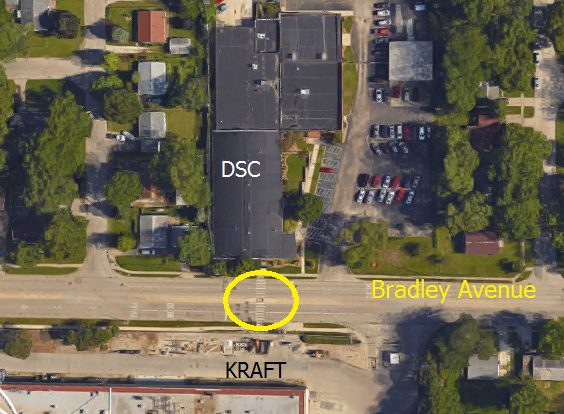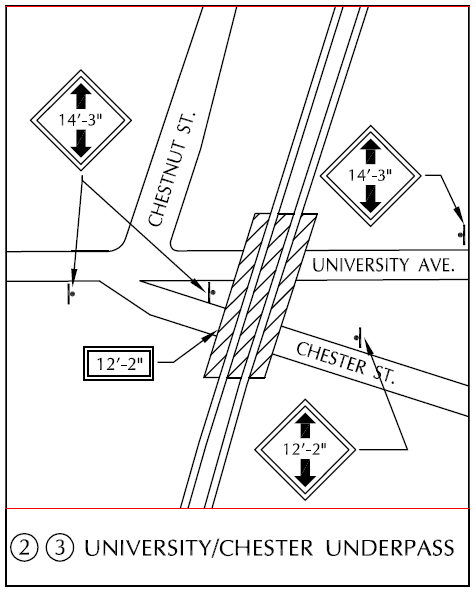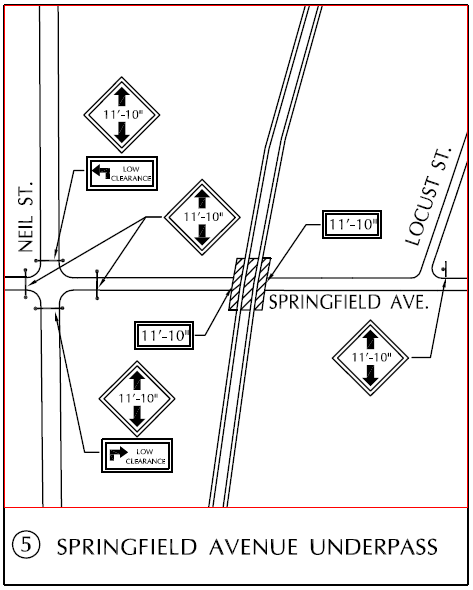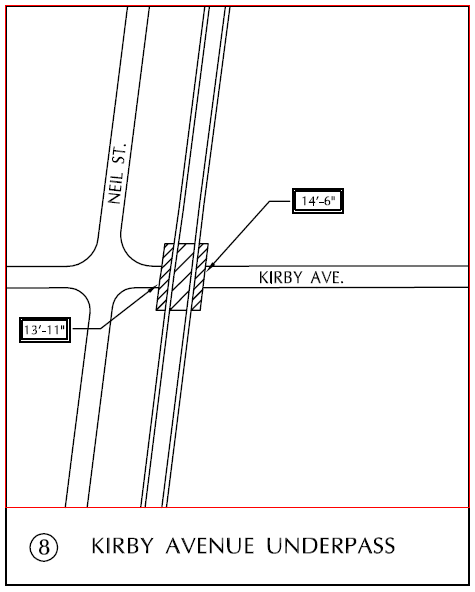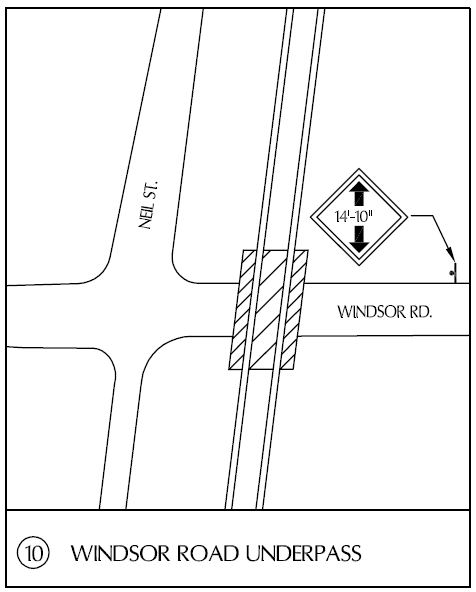STREETS & SIDEWALKS
 The City’s Adopt-a-Highway Program is available to all groups who are an established organization with an acting President and Group Coordinator. Groups are required to provide a list of volunteers with signed waivers, schedule cleanups at least four times per calendar year, and remove and dispose of all collected litter.
The City’s Adopt-a-Highway Program is available to all groups who are an established organization with an acting President and Group Coordinator. Groups are required to provide a list of volunteers with signed waivers, schedule cleanups at least four times per calendar year, and remove and dispose of all collected litter.
The City’s responsibilities include providing training resources for the Group Coordinator, providing the safety signs required for cleanup, providing safety vests for the volunteers, and placing Adopt-a-Highway signs at adopted sections of roadway.
The roadways must be located within the City of Champaign and must be at least one mile in length. The City suggests roadways that are considered primary roadways. Depending on the circumstances, secondary roads may be considered but are not recommended. Approval of the selected roadways by the Administrative Services Division is required.
Contracts will be for a maximum of three years; however, the City reserves the right to cancel an agreement if the terms of the contract are not being fulfilled. Contracts can be renewed after the initial two-year commitment. Participating groups will be required to provide cleanup of their adopted roadway on at least four occasions annually. Cleanups will be required, at least once each, in the spring, summer, and fall. A fourth cleanup can be scheduled at the convenience of the group. More than four cleanups are encouraged, but not required.
Cleanups should be scheduled in writing two weeks in advance of the desired cleanup date and accompanied by a list of participants with waivers on file. This can be accomplished by sending an e-mail to [email protected]. Please put “Adopt-a-Highway” and the group name on the subject line.
Groups are responsible for removing all materials collected during cleanups. All materials easily handled by one person should be cleaned up and removed. Items too large to be collected should be brought to the City’s attention. The groups are responsible for disposal of the material; however, materials may be brought to the Public Works Department, 702 Edgebrook Drive, Champaign, Illinois, Monday through Friday, except City Holidays, from 7:30 a.m. to 2:30 p.m.
Groups shall ensure that all volunteers have participated in safety training. Safety training should be provided by the Group Coordinator. All volunteers are required to wear City-supplied safety vests while engaged in the project. Groups will set up City-supplied signs as directed by the City.
For additional information contact:
Adopt-a-Highway Coordinator
Public Works Department
702 Edgebrook Drive
Champaign, IL 61820-2198
217-403-4700
[email protected]
The State of Illinois also has an Adopt-a-Highway program.
Right-of-way shall mean property owned by the City for use by the public as a means of passage; and shall include the street, alley, sidewalks, and parkway. It is intended for traffic movement, utilities, and similar public uses such as roads, clear zones for traffic safety, sidewalks, and pathways for pedestrian safety, utility services above, at, and below ground, and for snow storage. A right-of-way generally extends 25 to 33 feet from the centerline of the road onto the lawn area.
During the winter season, the right-of-way behind the roadway is reserved for snow storage to expedite snow removal. This area may extend seven feet or more beyond the road edge. Information about landscaping and maintenance in these areas can be found in Chapter 35-18 of the City’s Municipal Code .
Rights-of-way vary in width, with most being 50 to 66 feet wide.
2007 Pavement Markings Master Plan
Mowing
The Street Section is responsible for mowing City-owned vacant lots. The Champaign Park District maintains certain lots designated for the future Boneyard Creek projects under contract. The City also maintains the mowing of certain ditch lines and overpasses in the rural areas that are deemed “un-mowable” (deep ditch lines, etc.). All other parkway maintenance is the responsibility of the property owner.
Permits
The following is a list of permits available through the Public Works Department and will be discussed in detail below:
- Right-of-Way Occupancy Permit
- Right-of-Way Excavation Permit
- Drive Approach Permit
- Sanitary Sewer Permit
- Storm Sewer Permit
- Sidewalk Permit
- Grading and Drainage Permit
Permits are required by the Champaign Municipal Code and are discussed in further detail in Chapter 30, which covers Streets, Sidewalks, and Public Ways. Section 30-400 states that “Except pursuant to a permit issued by the City, no person shall construct any facility, or perform any work on a facility, on, over, above, along, upon, under, across, or within any City right-of-way or occupy City right-of-way.” The person performing work shall furnish the City Engineer with evidence of insurance coverage naming the City of Champaign as an additional insured. A $10,000 bond is required for excavations in public ways. The City Engineer’s representative reserves office hours for the purpose of issuing permits from 7:30 a.m. to 8:30 a.m. and 1 p.m. to 2 p.m., Monday through Friday, except City Holidays, at the Public Works Department, 702 Edgebrook Drive.
Right-of-Way Occupancy Permit:
The City Engineer is empowered to issue a right-of-way occupancy permit for any use of City streets or other public property of periods of no longer than 180 days for construction purposes.
Fees for issuance of a temporary permit pursuant to this section shall be as follows:
| For Up to 7 Days | For Each Day 8-180</span | |
| Major Arterial Street | $70.00 | $120.00/lane/day</span |
| Minor Arterial Street | $70.00 | $60.00/lane/day |
| Commercial Collector Street | $70.00 | $30.00/lane/day |
| Residential Collector Street | $70.00 | $12.00/lane/day |
| Local Street | $70.00 | $6.00/lane/day |
| Alleys | $70.00 | $6.00/1/2 alley/day |
| Sidewalk/Parkway | $70.00* | $60.00/sidewalk/day |
| *Fee waived if adjacent street permit is issued on same date. |
Fees for total closure of the street shall be double the lane fees.
Occupancy of a traffic lane requires payment for the adjacent on-street parking, if metered.
Right-of-Way Excavation Permit:
Section 30-430 of the Champaign Municipal Code states “no excavations or trenches in any public right-of-way in the City for any purpose including but not limited to sewer, drain, water, gas, steam, electrical, telephone, cable, video, internet, or other communication services and lines shall be made without first obtaining a permit from the Director of Public Works as provided in this Article”. The permit fee is $25.
Drive Approach Permit:
A driveway approach permit shall mean that part of a driveway or of any asphalt or concrete surface or pavement located in public right-of-way. A permit is required for any work covering the construction, maintenance, or repair of a driveway approach. The permit fee is $70.
Sanitary Sewer Permit:
No person shall install, connect, or replace any private or public sewer without first obtaining any necessary approval and permits from the City Engineer, the Urbana Champaign Sanitary District, and the Environmental Protection Agency of the State. The City fee for the permit is $70.
Storm Sewer Permit:
A permit is required to make a new connection or modification to an existing connection to the stormwater drainage system or to make any connection, which causes stormwater runoff to empty into the stormwater drainage system. The permit fee is $70.
Sidewalk Permit:
A permit is required to construct, maintain, or repair a sidewalk in the right-of-way. The permit fee is $70 per 100 lineal feet or part thereof.
Grading and Drainage Permit:
A permit is required for all construction/improvements with 500-sq. ft. or more of new impervious area. A grading and drainage permit plan will need to be submitted with the permit application. Information required on the grading and drainage permit plan includes (most of this information can be found on the subdivision plans or interpolated from them):
- Lot corner elevations.
- Building pad elevations.
- Lowest finished floor elevation.
- Surface water flow patterns.
- Statement that the project is (is not) within 100 feet of a 100-year floodplain.
- If the project is within 100 feet of a 100-year floodplain, the boundaries (if on the site) and elevation of the floodplain must be indicated, and the lowest floor of any habitable building must be at least one foot above the 100-year flood elevation.
All new construction and renovations that are not in a floodplain require a grading and drainage permit before work starts, except a permit is not required for:
- Excavation or fill less than 50 CY, with less than a 4-foot cut, disturbing less than 5,000 SF of plant cover.
- Any interior remodeling.
- Additions, remodeling, or accessory structures smaller than 500 SF which disturb less than 2,000 SF on the site.
- Demolition.
- Accessory items with minimal impact on drainage like: Sidewalks, playground equipment, decks, small patios, athletic fields, etc.
Development within a floodplain is much more tightly restricted. If you are working within a floodplain, call Public Works at 217-403-4700 for details. If you don’t know whether or not you are within a floodplain, call Public Works or search for your address at www.floodsmart.gov. For more information on floodplains, click HERE.
Permit fee schedule, effective April 1, 1998:
- One- and Two-family new construction and additions, $50
- Commercial new construction and additions, with total impervious area under 15,000 SF, $200
- Commercial, with total impervious area between 15,000 SF and 75,000 SF, $400
- Commercial new construction and additions, with total impervious area over 75,000 SF, $600
- Construction in flood fringe, take above rates x 1.5
- Construction in floodway, take above rates x 2.0
For information on erosion control, click HERE.
The Public Works Department responds to approximately 500 pothole patching service requests requests per year. Requests are placed via e-mail: [email protected]; phone: 217-403-4700; or by using the See-Click-Fix mobile app.
What causes a pothole?
Over time, cracks will develop in pavements and allow water, ice, and incompressibles into the pavement structure. The material under the pavement may begin to erode, causing the pavement to break or chip and eventually form potholes or larger cracks. Repeated freezing and thawing temperatures combined with wet pavement cause the cracks to further expand and deteriorate under the weight of traffic. In many instances, this process may cause potholes to develop overnight where none may have existed. High-traffic intersections and bus-stops are also prone to potholes–causing pavement to crack as a result of the weight of vehicles resting on the pavement.
What is your response time for filling potholes, and why is it sometimes not met?
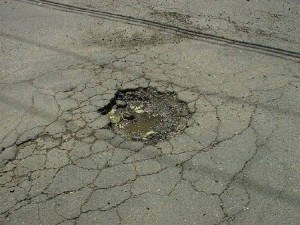 Generally, our response time is within 24-48 hours. However, during harsh winter seasons where streets may have hundreds of potholes, this time frame may not always be met. There are several reasons why we may not meet this time frame: (1) The pothole is off the side of the road. Sometimes potholes form on the side of the road where drainage is poor and the area is used for parking. If the pothole is in the City’s right of way, we will repair it. (2) It can’t be repaired through simple pothole patching. Some defects reported as potholes are really some other kind of problem that can’t be repaired the same way as a pothole. Sometimes the road is rutted or rough, there is a possible void or sink hole, or the street is crumbled. This requires a longer-term fix and is submitted for a major repair. (3) The pothole may be on a state-owned (non-city owned street). IDOT owns several streets within the area and have their own procedures for repairing potholes. We do, however, coordinate with them and may repair some of their potholes on an emergency basis when public safety is at risk.
Generally, our response time is within 24-48 hours. However, during harsh winter seasons where streets may have hundreds of potholes, this time frame may not always be met. There are several reasons why we may not meet this time frame: (1) The pothole is off the side of the road. Sometimes potholes form on the side of the road where drainage is poor and the area is used for parking. If the pothole is in the City’s right of way, we will repair it. (2) It can’t be repaired through simple pothole patching. Some defects reported as potholes are really some other kind of problem that can’t be repaired the same way as a pothole. Sometimes the road is rutted or rough, there is a possible void or sink hole, or the street is crumbled. This requires a longer-term fix and is submitted for a major repair. (3) The pothole may be on a state-owned (non-city owned street). IDOT owns several streets within the area and have their own procedures for repairing potholes. We do, however, coordinate with them and may repair some of their potholes on an emergency basis when public safety is at risk.
Why are there so many potholes during the winter and spring?
The high moisture conditions of the winter and spring months, combined with the freeze-thaw temperature fluctuations cause significant stress on pavements which lead to the formation cracks and potholes. The patching material that is placed in the large cracks and potholes is often only a temporary fix. Snow plowing operations can scrape patching material out of the hole and constant traffic can push and shove the patching material out of the hole, leaving the hole exposed again to moisture and freezing temperatures. Water in the hole will erode away the surrounding pavement making the hole larger. You can expect a greater accumulation of potholes during winter seasons with high snowfall or spring seasons with high rainfall. Potholes may also form when the weather is sunny and clear, after a storm, due to large amounts of runoff from melting snow.
How can I report a pothole?
Various methods are available to report a pothole. These include emailing or calling Public Works and submitting a service request, or using the See-Click-Fix mobile app available for free download.
![]() May I request a cone or barricade for potholes on my street?
May I request a cone or barricade for potholes on my street?
You may request cones or barricades for potholes on your residential street; however, Public Works will determine whether the placement of the cone or barricade may be more detrimental to traffic flow and take other measures to alleviate the problem.
When will your pothole patching crews get to my neighborhood to fix potholes (after harsh winter seasons or spring storms)?
Pothole patching crews use a systematic approach to fixing potholes. Rather than moving (often heavy) equipment to respond to a single pothole on one side of town and then responding to another request at the opposite end of town, we localize our approach to make the most efficient use of assets. However, we do respond to emergency repairs with a smaller crew when available.
What kind of equipment does the City use to fix potholes?
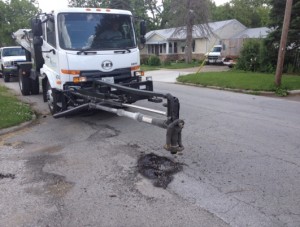 Public Works has various pieces of equipment to fix potholes, but most pothole patching requires the physical labor of our crews shoveling asphalt from the back of truck beds or front-end loader buckets (scoops). Additionally, Public Works has equipment designed specifically for pothole patching. These include: (1) Our Pothole Sprayer-Injector truck which provides a more-efficient manner of patching potholes and (2) our Hot-asphalt (warmer) truck which makes shoveling hot-asphalt much easier for our crews.
Public Works has various pieces of equipment to fix potholes, but most pothole patching requires the physical labor of our crews shoveling asphalt from the back of truck beds or front-end loader buckets (scoops). Additionally, Public Works has equipment designed specifically for pothole patching. These include: (1) Our Pothole Sprayer-Injector truck which provides a more-efficient manner of patching potholes and (2) our Hot-asphalt (warmer) truck which makes shoveling hot-asphalt much easier for our crews.
Public Works also rents equipment from time-to-time when an inordinate amount of potholes form during harsh winter or spring seasons.
What can I do to help?
While we appreciate the offer from citizens to help out with patching potholes, Public Works crews are trained to operate in hazardous conditions (such as traffic) and require additional training. The best thing a citizen can do is report a pothole and slow down when they see crews patching potholes on City streets.
The City encourages citizens to report potholes to the Operations Division at 217-403-4700, between 7:30 a.m. to 4:30 p.m., Monday through Friday, except City Holidays. Please provide City staff with your name, address, telephone number, location of pothole, and as much detailed information as possible. This information is very helpful to staff trying to respond to your request. After business hours, on weekends, or holidays you will receive a pre-recorded message with general instructions and emergency information. Please leave detailed information to ensure prompt response. You can also email the department at [email protected] or try the City’s free mobile reporting app SeeClickFix (available through the iTunes store or Google Play for Android).
The Concrete Section of the Public Works Operations Division manages the City’s sidewalks. Please contact the Public Works Operations Division at 217-403-4700 if tripping hazards are identified.
STREETLIGHTS, SIGNS, & TRAFFIC SIGNALS
If you have noticed a streetlight that is out, dim or blinking, please call 217-403-4700 during the normal working hours of 7:30 a.m. to 4:30 p.m. You can also report a streetlight malfunction by e-mailing us: [email protected].
The following information is useful to identify a specific light:
- Address where the light is positioned on the street.
- Side of the street the light is on.
- Please leave your name and a daytime phone number so we may call with questions if necessary.
Once a report has been made, the City will determine who owns the light. If it is a City-owned light, efforts to repair the light within 48 hours are made. If it is an Ameren Illinois light, the City will notify Ameren of a problem as they are responsible for repairing the light.
 To report a sign knockdown or missing sign during normal working hours of 7:30 a.m. to 4:30 p.m., please contact Public Works at 217-403-4700 or send an email to [email protected].
To report a sign knockdown or missing sign during normal working hours of 7:30 a.m. to 4:30 p.m., please contact Public Works at 217-403-4700 or send an email to [email protected].
To report a sign knockdown or missing sign after hours, please call 217-403-4700.
Concerns, requests, and suggestions regarding traffic safety are considered Traffic Service Requests. Generally, these requests ask for something new or for a change to an existing condition. Some examples of common Traffic Service Requests include:
- Installation of stop signs
- Changes to parking restrictions
- Issues related to crosswalks
- School area concerns
- Concerns regarding speed of traffic in residential neighborhoods
Requests can be submitted by contacting the Public Works Department at 217-403-4700 or [email protected].
 To report a traffic signal outage or malfunction during normal working hours of 7:30 a.m. to 4:30 p.m., please contact Public Works at 217-403-4700. You can also report routine signal outages or malfunctions to our email at [email protected].
To report a traffic signal outage or malfunction during normal working hours of 7:30 a.m. to 4:30 p.m., please contact Public Works at 217-403-4700. You can also report routine signal outages or malfunctions to our email at [email protected].
For after-hours emergency traffic signal problems, please call 217-351-4545, and select option “0”.
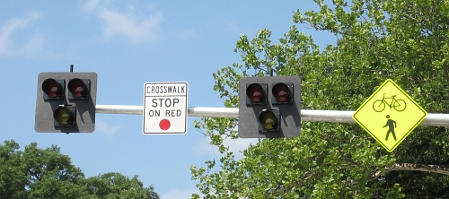 How a HAWK signal works
How a HAWK signal works
HAWK Signal Demonstration Video
Where is it?
BRADLEY AVENUE at DSC
Why is it needed?
Bus stops located on both sides of Bradley Avenue at Developmental Services Center are highly utilized by patrons of DSC and area residents. This section of Bradley Avenue is perpetually on the list of streets with speeding problems with the majority of drivers regularly driving 10 or more miles per hour over the posted 35 mph speed limit.
Over the years, the City of Champaign and DSC have worked together to use all available tools for an uncontrolled pedestrian crossing to make it as safe as possible. The HAWK takes the next step for enhancing pedestrian safety by requiring vehicular traffic to stop.
RAILROAD UNDERPASS CLEARANCES
There are 10 underpass structures in the City of Champaign along the Canadian National Railroad (CNRR). Below is information listing the structure locations, warning sign locations, and clearance heights of the underpasses.
- The Illinois Vehicle Code (625 ILCS5/15-103) establishes the maximum height of a vehicle to be 13 feet 6 inches.
- The Illinois Manual on Uniform Traffic Control Devices requires all underpasses with clearance less than the maximum legal vehicle height plus 12 inches be posted with the low clearance signs.
- All underpasses in the City of Champaign are posted with warning signs.
- Only University Avenue, Kirby Avenue, and Windsor Road underpasses are tall enough for any legal vehicle to pass under.
- The CNRR owns and maintains all the underpass structures except Windsor Road, which is owned and maintained by the City of Champaign.
Jurisdiction of Streets
The ownership of a street determines who is responsible for its maintenance. Streets within the City’s corporate limits are either privately owned or owned by the City, University of Illinois, or Illinois Department of Transportation. The following links illustrate the City’s corporate limits and its jurisdiction of streets.
- Map of Champaign’s City Corporate Limits
- Map of Champaign’s Jurisdiction of Streets
- 2002 Bridge Master Plan
For more information, please contact:
City of Champaign
Public Works Department
702 Edgebrook Drive
Champaign, IL 61820
217-403-4700
[email protected]


